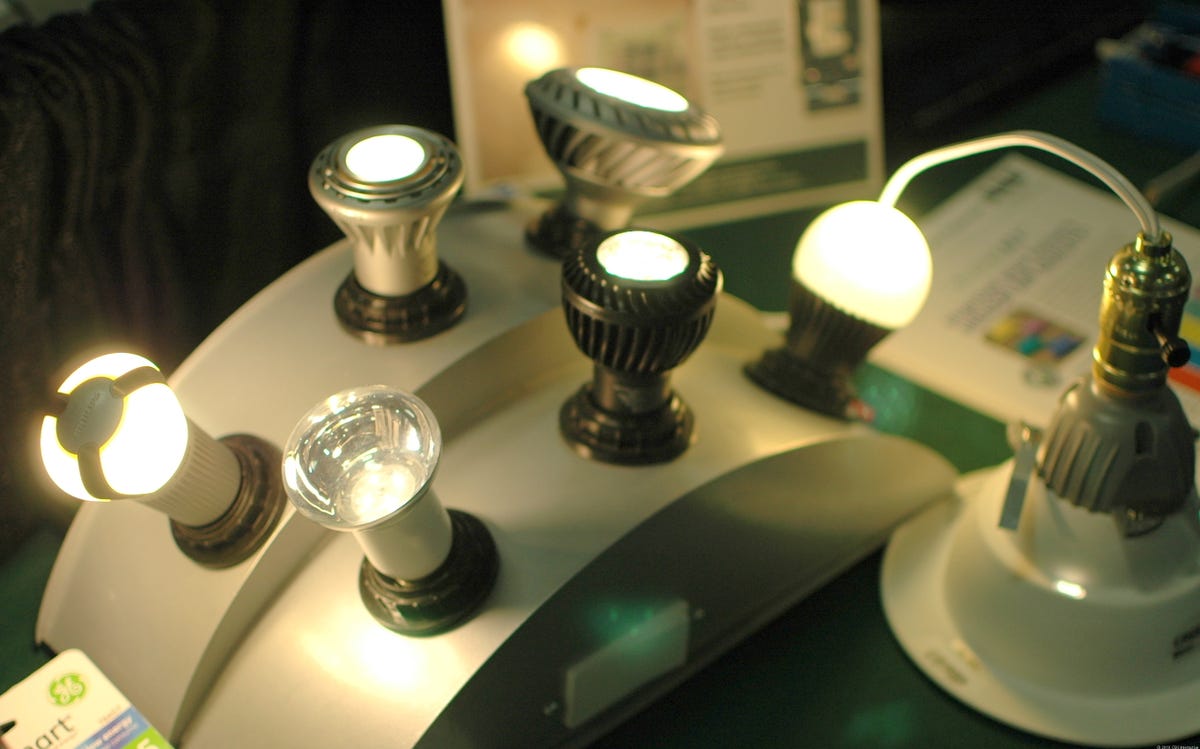Tools of the green building trade (photos)
At the annual Building Energy conference in Boston last week, everything from efficient appliances to biomass heating is on display.

LED bulbs
BOSTON--The Northeast Sustainable Energy Association every year puts on the Building Energy conference here, where there are green building products on display. One of the few new products at this year's event last week were these LED bulbs for the home. On the far left is a 60-watt equivalent from Philips and on the far right is a downlight from Cree. LED bulbs are far more efficient than incandescent bulbs and more efficient than compact florescents. They are also supposed to last 15 to 25 years. The problem? Cost. The Philips bulb costs almost $40. Costs are coming down, though, and there are some rebates available.
Solyndra solar collector
This is a solar collector from Solyndra, one of the many solar companies started in the U.S. to take advantage of relatively cheap thin-film solar cells. The solar cells (in black) are wrapped around glass tubes and can collect light from the top and, when reflected off the white membrane, from the bottom. Installation of the solar collectors, which are designed for flat roofs, is quick since the collectors are self ballasting and don't need to be screwed into rooftops.
Biomass heat
Pellet stoves for households have become more popular in the past few years as people seek out alternatives to oil and gas heating. Pellets are considered a low-carbon renewable fuel since they come from wood product residue. This is a pellet boiler made in Austria from Okofen. It's designed for commercial customers, a market that is more developed in Europe. Oil distributor Sandri has now begun making deliveries of locally-made pellets to some businesses in western Massachusetts.
Geothermal well head
Geothermal systems--more correctly called ground source heat pumps--are one of the most efficient ways for heating and cooling buildings. They work by pumping water from wells, which can be hundreds of feet underground, into a heat pump to cool or heat air. This photo shows the inside of a well that would be placed underground.
Smart appliance
Here is a look at General Electric's GeoSpring hybrid hot water heater, which the company says is more efficient than tankless hot water heaters. Similar to a ground-source heat pump, it uses a compressor and an evaporator to get heat from the outside air as well as traditional condenser coils.
This is also the first in the line of GE's "smart appliances" which will be able to communicate with smart meters to save consumers money by cutting down on peak time power use. If you look carefully, you can see a white Ethernet port, which will have a controller that will talk with a home network gateway to communicate with a utility.
Solar hot water circulator
When it comes to solar energy, most people seem to think of solar photovoltaics, or electricity-producing panels. But solar hot water systems are cheaper upfront and typically pay for themselves faster. On the other hand, electricity is a more versatile carrier of energy, compared to hot water.
Sunnovations is a company that showed off a solar hot water circulation system that does away with pumps. Instead, the heat from the panels creates a "geyser pump" that pushes the heated fluid and powers the circulation system. In addition to saving money on pumps, the system will work with cheaper tubing because it doesn't operate at high pressure, according to company representatives.
Solar hot water tank
Here's a cutaway of a traditional solar hot water storage tank and pump system. Solar collectors heat up a fluid, usually an antifreeze, and pumps send that hot fluid into a tank. The hot fluid circulates through copper pipes in a storage tank like this one to transfer heat to water in the tank. The preheated hot water is fed into a normal hot water heater, saving energy.
Evacuated tubes
Solar hot water collectors use copper to collect heat and transfer it to water. They can be flat panels or evacuated tubes as is this one from German manufacturer Viessmann. This photo shows how copper fins, painted a dark color, act as a solar collector. Fluid flows through small pipes within each tube to a heat exchanger.
Thermal camera
Building professionals have a few tools to determine how energy efficient a building is, including infrared cameras that pick up heat. They can take a photo of a door or drop-down attic staircase, for example, to see how much heat is being lost to air leakage or lack of insulation. Another important tool to determine air leakage is a blower door.

